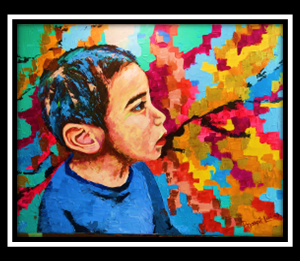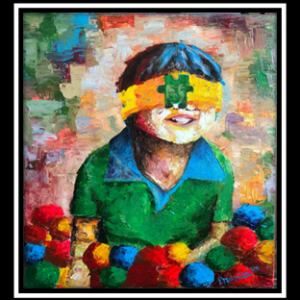In a Kaleidoscope World: Looking Through the Lenses of Children and Young Adults with Autism
A special painting exhibition by Ms. Precious Nakpil-Lai
Not so Messy Play, 2023
Acrylic on canvas, 92 x 102 cm
Title: Navigating the Sensory World: Children with Autism, Tactile Sensitivities, and Messy Play
Introduction
Autism Spectrum Disorder (ASD) is characterized by a range of sensory sensitivities that can profoundly impact a child’s daily life. Among these sensitivities, tactile sensitivity stands out as a common challenge. This essay explores the intersection of children with autism, their tactile or sensory sensitivities, and the benefits of messy play as a therapeutic approach.
Understanding Tactile Sensitivities
Tactile sensitivities, or hypersensitivities, refer to heightened responses to touch and textures. Children with autism may experience these sensitivities differently, but common reactions include discomfort, avoidance, or distress when encountering certain textures, fabrics, or tactile sensations.
Challenges of Tactile Sensitivities
Tactile sensitivities can present significant challenges for children with autism. Everyday activities like getting dressed, taking a bath, or even hugging a family member can become sources of anxiety and stress. Tactile sensitivities can hinder a child’s ability to explore their environment, engage in social interactions, and participate in sensory-rich activities.
Messy Play as a Therapeutic Approach
Messy play, also known as sensory play, involves activities that engage a child’s senses, particularly touch and sometimes taste and smell. It often includes materials like sand, water, mud, paint, or various textured objects. While messy play might seem counterintuitive for children with tactile sensitivities, it can be a valuable therapeutic approach for several reasons:
- Desensitization: Engaging in messy play can gradually desensitize a child to different textures and tactile sensations. Over time, exposure to a variety of textures can reduce their aversion and discomfort.
- Sensory Exploration: Messy play provides a controlled and enjoyable way for children to explore different sensory experiences. It allows them to touch, squeeze, and manipulate materials, promoting sensory integration and self-regulation.
- Communication: Messy play can serve as a form of non-verbal communication. Children with limited verbal communication skills can express their preferences and emotions through their engagement with different materials and textures.
- Stress Reduction: Contrary to expectations, many children with tactile sensitivities find messy play relaxing and enjoyable. The sensory-rich experience can reduce anxiety and stress.
- Promoting Creativity: Messy play encourages creativity and imagination. Children can experiment with different materials, textures, and colors, fostering cognitive and artistic development.
Implementing Messy Play for Children with Autism
When introducing messy play to children with autism and tactile sensitivities, it’s important to consider their unique needs and preferences:
- Gradual Introduction: Start with less challenging textures and materials and gradually progress to those that are more challenging. This gradual exposure can help children become more comfortable over time.
- Individualized Approach: Each child with autism is unique, and their sensory preferences vary. Tailor messy play activities to match their specific sensitivities and interests.
- Sensory-Friendly Materials: Choose materials that are safe, non-toxic, and appropriate for the child’s age and developmental level.
- Supervision and Support: Provide guidance and support during messy play activities, ensuring the child feels secure and understood.
Conclusion
Tactile sensitivities can pose significant challenges for children with autism, affecting their daily routines and social interactions. Messy play, when implemented thoughtfully and with individualized consideration, can be a valuable therapeutic tool. It offers opportunities for sensory exploration, desensitization, stress reduction, and creative expression. By embracing messy play as a means of navigating the sensory world, we can better support the unique needs and development of children with autism, allowing them to engage more fully in the world around them.






Reviews
There are no reviews yet.